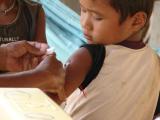In 2022, Europe experienced the biggest diphtheria outbreak in the region in 70 years, and authors writing yesterday in the New England Journal of Medicine have traced the outbreak strain to known migration routes and migrant communities in European countries—and not necessarily to patients' countries of origin.
Moreover, the authors identify a genetic link between the 2022 strain and an epidemic in Germany this year, suggesting the bacterium that causes the disease is circulating undetected in Western Europe.
362 cases in 10 nations
Mass vaccination had largely eliminated diphtheria in Europe, and between 2016 and 2020, an annual average of 27 diphtheria cases caused by Corynebacterium diphtheriae were reported in the European Union and European Economic Area (EU/EEA), according to a news release from the European Centre for Disease Prevention and Control (ECDC).
But from January to November 2022, 362 cases were identified in 9 European countries: Austria, Belgium, France, Germany, Italy, Norway, the Netherlands, Spain, Switzerland, as well as the United Kingdom. Those sickened were largely migrants who had relocated to Europe: Germany (118 patients) and Austria (66 patients) had the largest case counts.
The median age of the patients was 18 years at the time of data collection; 176 patients (48.6%) were 16 to 20 years of age, and 355 (98.1%) were male, the authors wrote. The vast majority of the patients (96.1%) had a recent migration history, close contact with migrant populations, or a recent date of entry into the reporting country. Roughly half of all patients (48.1%) were reported to be residents of a migrant center.
Most migrants from Afghanistan, Syria
A total of 19 countries of origin were reported among case-patients; 222 patients (83.5%) were reported to have originated from Afghanistan or Syria. In addition, 28 transit countries were reported
"Although several patients migrated from Africa or through eastern Europe, most followed a migration route through the western Balkans," the authors wrote.
Of 436 patients with clinical data, 268 (77.5%) had cutaneous diphtheria, 53 (15.3%) had respiratory diphtheria (11 [3.2%] had a pseudomembrane), and 9 (2.6%) had both respiratory and cutaneous symptoms. Isolates collected from patients showed four genetic clusters.
People who left their home countries without the disease contracted diphtheria on their way to the destination country where they were diagnosed.
"Our analysis illustrates that closely related diphtheria clones were detected in multiple European countries, which tells us that people who left their home countries without the disease contracted diphtheria on their way to the destination country where they were diagnosed," said Andreas Hoefer, PhD, at ECDC and one of the co-authors of the study.
Case counts dropped significantly by the spring of 2023.
"The rise in the number of C. diphtheriae infections observed among migrants in western Europe in the second half of 2022 was seemingly halted by response measures, but some forward transmission in the reporting countries was observed in 2023," the authors wrote.
However, as the ECDC reports, in April 2025, Germany confirmed a diphtheria outbreak caused by a C. diphtheriae sequence type that was originally linked to the 2022 outbreak and was also detected in a few cases in 2023.
"According to the information from Germany, diphtheria cases were reported among people experiencing homelessness, an older adult and an unvaccinated child," the ECDC said. "Following this recent outbreak signal from Germany, ECDC is in close contact with EU/EEA Member States and will update its risk assessment and recommendations based on the new data."
According to a press release from the Pasteur Institute, a total of 536 cases, including at least 3 deaths, have been reported in Europe since the start of the 2022 epidemic.
Isabelle Parent du Châtelet, unit manager at Santé publique France, which helped fund the study, said, "The study shows how important it is to ensure that diphtheria immunization levels are up to date, particularly for vulnerable population groups, such as migrants, and that diphtheria poses a risk especially among homeless people, injecting drug users, unvaccinated individuals and elderly people with pre-existing illnesses.'

















